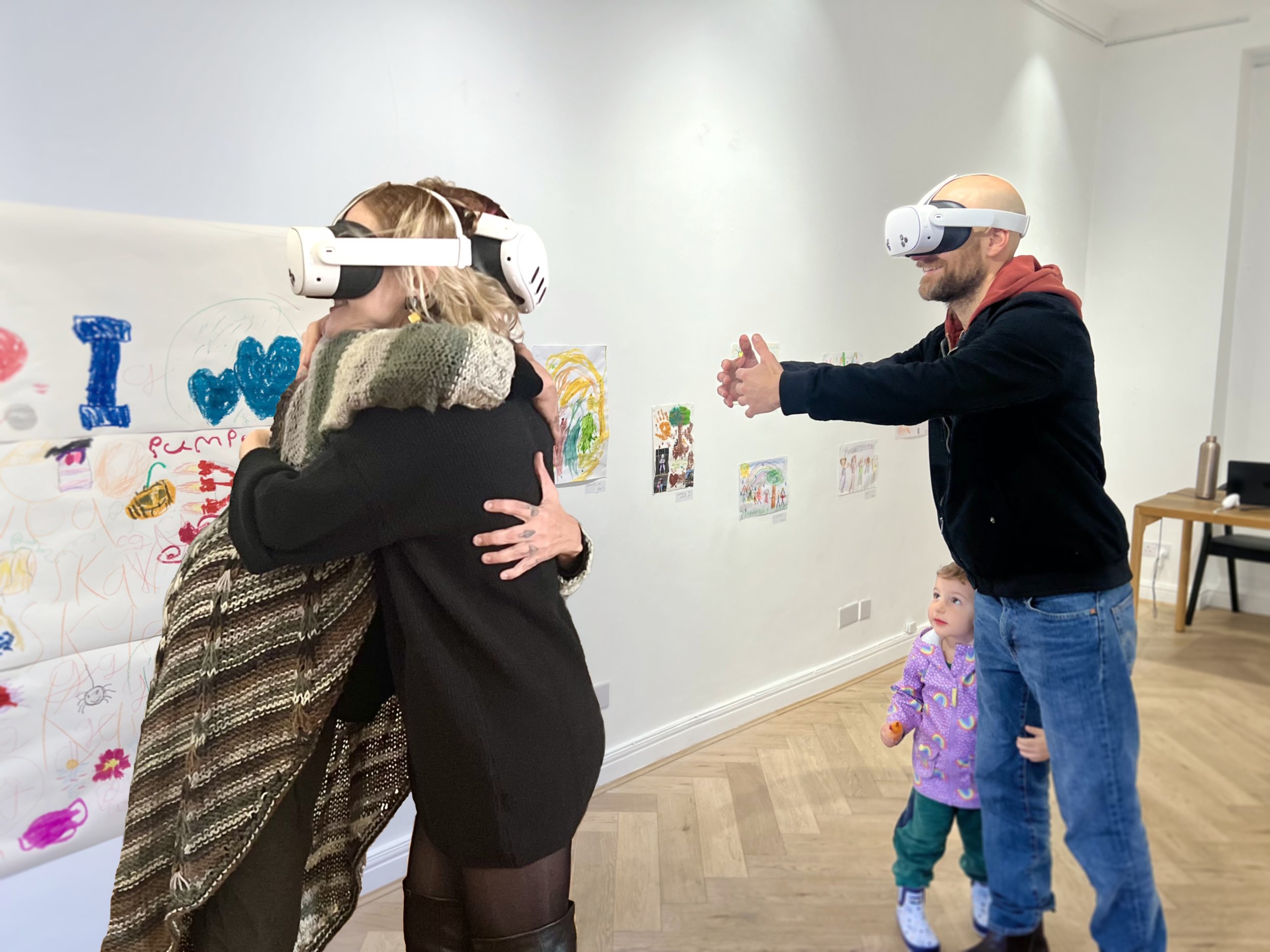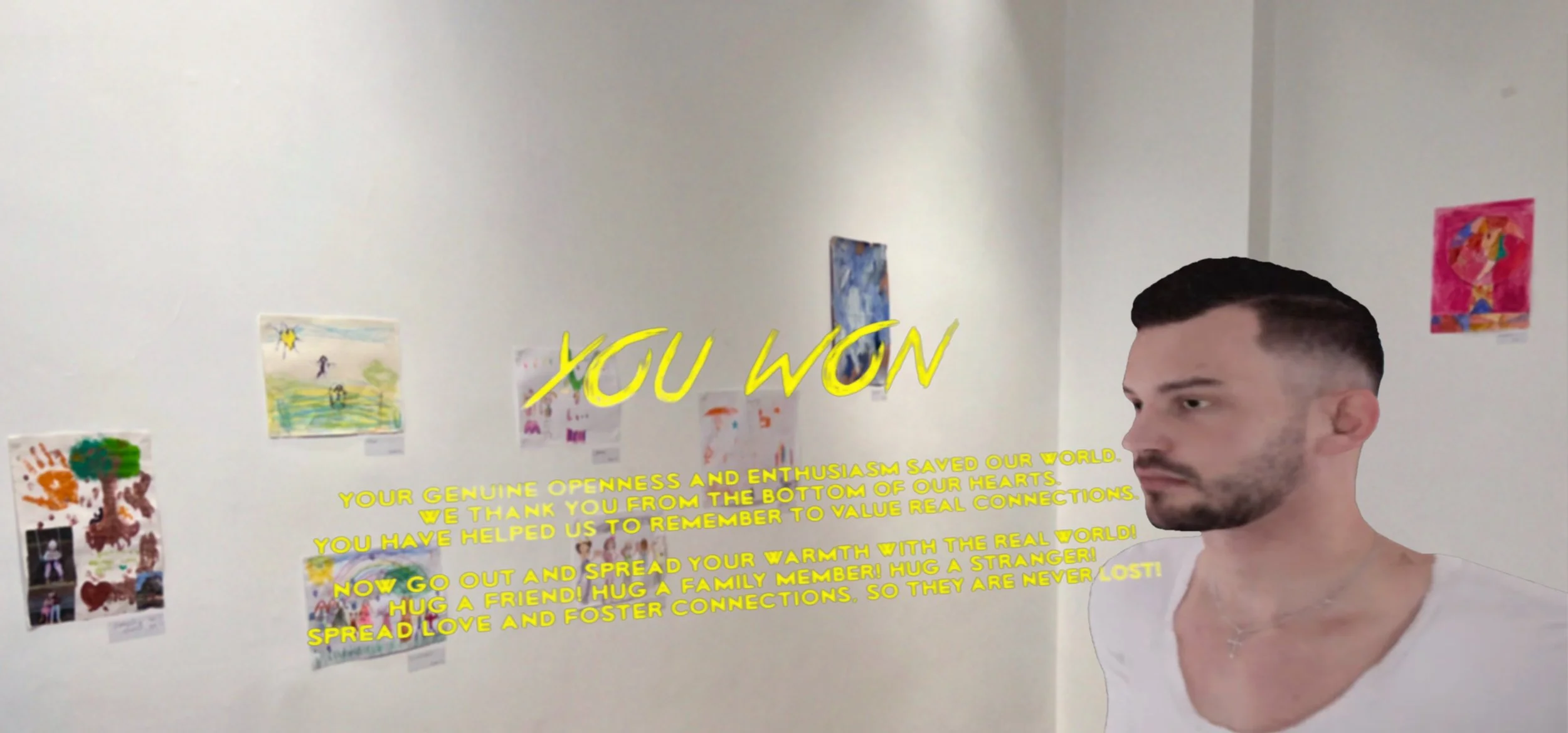Embrace: Skye Von on Reimagining Connection Through Immersive Art
By Cansu Waldron
When you first encounter Embrace, it feels disarmingly simple — a gesture, a hug, a shared breath between strangers mediated by technology. But linger a little longer, and you realize that simplicity is the point. In a time when connection is often flattened into notifications, this mixed-reality installation reawakens a sense of presence that many of us have forgotten. Developed originally at the New Museum’s NEW INC in New York and recently reimagined in London and Harwich, Embrace transforms digital space into a poetic site of empathy — one where technology doesn’t distance, but brings us closer.
The project is created by Skye Von, a multidisciplinary artist and creative director whose practice blurs the lines between storytelling, interaction, and social design. Raised in the UK, born in Austria, and shaped by years working across the US and Europe, Skye brings a rare cross-cultural perspective to her work — one that bridges the commercial and the deeply human. With over 15 years in experiential art and brand storytelling, she describes herself as a narrative play artist, someone who uses story, space, and participation to transform audiences from passive viewers into active participants.
In Embrace, Skye invites participants to restore color and balance to a fading world through presence and consensual touch — a quiet metaphor for how connection and empathy can reawaken the spaces between us. What makes her work stand out in today’s crowded immersive art scene is its sincerity. Rather than overwhelming the senses, she creates spaces for tenderness and reflection, using mixed reality as a tool for grounding rather than escape. Here, technology becomes a conduit for care — not the subject, but the bridge.
In the conversation that follows, Skye and I talk about how Embrace came to be, the ideas that shape her practice, and how immersive art can heal rather than distract. We explore what it means to design for empathy in a hyper-digital world — and how play, presence, and participation can bring us back to what truly connects us.
EmbraceVR – NEW INC, New Museum, New York, USA. September 2019
You describe your approach as “creating moments that capture, connect, and create memories.” What does connection mean to you in the context of immersive and digital experiences?
For me, connection is about presence — those moments when people are truly in it rather than observing from the outside. Whether digital or physical, I’m interested in how participation restores presence to our hyper-stimulated lives. When people step into an experience and become part of it, through movement, storytelling, or shared imagination, they’re no longer consuming content, they’re inhabiting it. That’s when awareness deepens.
In my work, connection isn’t about technology itself but about what it enables: moments of shared presence, empathy, and self-recognition. My practice explores how storytelling, space, and interaction can converge to make people feel seen — to sense their impact within a larger living system. I use story and sensory engagement to turn ideas into something people can feel. My work is both poetic and participatory, blending art, science, and lived experience to reawaken empathy and understanding.
I’m not an abstract artist — I’m a narrative play artist. My background in theatre and visual art merges into installations that take audiences on a journey from A to Z, guided by story but leaving space for discovery. Play runs through everything I create: it sparks curiosity, invites participation, and turns learning into transformation. My storyworlds, from Embrace (a kind of video game about empathy) and You Are What You Eat (an escape-room-style journey through digestion) to JoyGaze (a meditative scavenger hunt through joy), all use play as a language of transformation.
Embrace at The Art Office, London, UK. October 2025
Embrace uses touch and presence to explore empathy through technology. What inspired that concept — and how did it evolve from your time at NEW INC to its reimagined version in the UK?
Embrace began in 2019 during my residency at the New Museum’s NEW INC in New York, as I explored how technology could deepen, rather than distract from, reality. I was fascinated by how virtual experiences could translate emotion into tangible form — and how consent, touch, and comfort could heighten empathy. The question driving it was simple: Can immersive technology bring people closer rather than isolate them?
I’ve always been drawn to science fiction and fantasy because they let us explore difficult subjects at a safe imaginative distance. The original installation was set in a near-future world where people had lost their ability to connect. Players revived fading avatars through consensual hugs as a poetic metaphor for reconnection in a fragmented world. Using pass-through VR, participants moved through desaturated city scenes that came back to life as they hugged, transforming into vibrant natural imagery symbolising renewal.
After the pandemic, isolation was no longer an idea but a lived experience. For the London and Harwich editions in 2025, I realised Embrace no longer needed a sci-fi frame. Instead of urban projections, participants were surrounded by children’s drawings on kindness and belonging — the imagination of those most present. Their artwork grounded the experience in real life and turned Embrace from a cautionary tale into a hopeful one, shifting the work from dystopia toward social healing.
Embrace at The Art Office, London, UK. October 2025
The involvement of local schoolchildren in Embrace adds a beautiful, communal layer. What was it like to bring their drawings and perspectives into your work?
It was profoundly moving. Their drawings didn’t just decorate the environment; they transformed its emotional tone — spontaneous, honest symbols of care and connection. Children express empathy with purity and freedom, grounding the installation in something real and immediate.
I see this not as inclusion but as collaboration but a form of collective authorship. I’m drawn to co-creation, especially with children, because they bring unfiltered emotional intelligence to the work. Their presence reminded audiences that empathy begins in childhood and must be continually relearned.
It also gave something back to the community where I live and raise my son, connecting my research on embodied learning with lived, local relationships. Their participation turned the installation into both artwork and social practice.
Embrace at The Art Office, London, UK. October 2025
In an age where technology often feels isolating, your work emphasises empathy and belonging. Do you think immersive tech has the potential to make us feel more connected?
Yes, but only if it’s used with intention. Technology is neutral; what matters is how it’s utilised. I treat it as a material, like light or sound, to choreograph emotion and attention.
In Embrace, the very medium that often separates us became the bridge back to presence and connection. Used with care, immersive tools can restore our capacity for awareness and shared emotion.
The same philosophy shapes my newer digital projects. JoyGaze is a participatory AI-based artwork and app that transforms photographed symbols of joy into generative meditations. It’s about technology helping us shift our real-world perspective, training ourselves to notice joy all around us. Culture Mix, an immersive AR/AI installation, which uses personal genealogy to explore our shared humanity. The installation uses projection mapping, spatial audio, and olfactory design to turn genealogy into a living sensory portrait. The concept grew from my fascination with how art, science, and technology can dismantle the illusion of separation: when you literally see and feel the global mix that makes you who you are, perceived boundaries begin to dissolve.
Across all mediums, I use technology not as escape or a spectacle, but as a mirror for connection and awareness.
Embrace at The Art Office, London, UK. October 2025
Can you tell us about a creative risk you’ve taken — a project or decision that taught you something unexpected?
Rebuilding You Are What You Eat from a £285,000 immersive bus installation into an £850 school-library prototype was one of my biggest creative risks. I wanted to test whether artistic intention could survive radical constraint. It turned out the smaller version was just as powerful, because the core — the story, characters, and children as co-creators — remained unchanged. That process led me to develop my R.E.V.E.A.L. framework, which uses creative subtraction to find meaning. It taught me that limitation is one of the most generative materials an artist can work with.
You Are What You Eat at Primary School London, London, UK. June 2025
What is a fun fact about you?
I started acting on stage when I was one and a half — my first role was literally being carried onto the stage in a basket. Theatre shaped everything I do. That live energy exchange with an audience never left. It’s why my work sits between installation, theatre, and play. Even now, I think of my experiences as staged encounters, performances that only exist through participation.
Embrace at The Art Office, London, UK. October 2025
What else fills your time when you’re not creating art?
My son and experiencing the world through his eyes. We spend weekends exploring, making art, and coming up with wild ideas together, not just for him but because I genuinely enjoy it.
Parenthood has been the greatest catalyst in my artistic evolution. It reconnected me with my own playful curiosity that fuels the same spirit that drives my work. He even inspired You Are What You Eat after asking to visit “The Poo Museum.” When I discovered it didn’t exist, I decided to make it an interactive adventure through a monster’s digestive system using humour and storytelling to teach about health and nutrition. Those shared moments remind me that wonder, curiosity, and play aren’t secondary to art — they are art.
Embrace at The Art Office, London, UK. October 2025
Have there been any surprising or memorable responses to your work?
One that stayed with me was from someone who said Embrace made them realise how long it had been since they’d been hugged by another person and how deeply they missed it. That vulnerability was exactly what I’d hoped to evoke.
Another was a boy with ADHD who returned repeatedly to You Are What You Eat because it held his focus like nothing else and made the subject matter exciting and personal. Those small shifts are the true measure of impact for me.
Embrace at The Art Office, London, UK. October 2025
Finally, what’s next for you? Are there new technologies, themes, or collaborations you’re excited to explore?
I’m continuing to expand You Are What You Eat across Camden schools, and further developing Embrace with UK research partners to study presence, emotion, and social connection in mixed reality. Alongside that, I’m growing Spark & Bond, a creative platform born from my artistic practice, turning my immersive art into playful learning experiences for families, turning complex topics like healthy eating, sustainability, and financial literacy into joyful adventures. All while developing JoyGaze and Culture Mix as part of my ongoing exploration of empathy, awareness, and transformation across digital and physical spaces, creating worlds where creativity leads to understanding, and understanding leads to change.
Embrace at The Art Office, London, UK. October 2025























